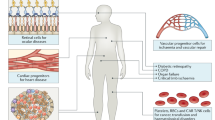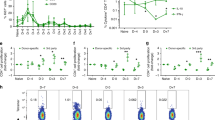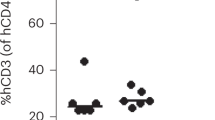Abstract
Although over 50 years have passed since its first laboratory description, intentional induction of immune tolerance to foreign antigens has remained an elusive clinical goal. We previously reported that the requirement for ABO compatibility in heart transplantation is not applicable to infants. Here, we show that ABO-incompatible heart transplantation during infancy results in development of B-cell tolerance to donor blood group A and B antigens. This mimics animal models of neonatal tolerance and indicates that the human infant is susceptible to intentional tolerance induction. Tolerance in this setting occurs by elimination of donor-reactive B lymphocytes and may be dependent upon persistence of some degree of antigen expression. These findings suggest that intentional exposure to nonself A and B antigens may prolong the window of opportunity for ABO-incompatible transplantation, and have profound implications for clinical research on tolerance induction to T-independent antigens relevant to xenotransplantation.
This is a preview of subscription content, access via your institution
Access options
Subscribe to this journal
Receive 12 print issues and online access
$209.00 per year
only $17.42 per issue
Buy this article
- Purchase on Springer Link
- Instant access to full article PDF
Prices may be subject to local taxes which are calculated during checkout





Similar content being viewed by others
References
Alexandre, G.P. et al. Present experiences in a series of 26 ABO-incompatible living donor renal allografts. Transplant. Proc. 19, 4538–4542 (1987).
Sutherland, D.E. et al. Long-term effect of splenectomy versus no splenectomy in renal transplant patients. Reanalysis of a randomized prospective study. Transplantation 38, 619–624 (1984).
Bannett, A.D., McAlack, R.F., Morris, M., Chopek, M.W. & Platt, J.L. ABO incompatible renal transplantation: a qualitative analysis of native endothelial tissue ABO antigens after transplantation. Transplant. Proc. 21, 783–785 (1989).
Chopek, M.W., Simmons, R.L. & Platt, J.L. ABO-incompatible kidney transplantation: initial immunopathologic evaluation. Transplant. Proc. 19, 4553–4557 (1987).
Cooper, D.K. A clinical survey of cardiac transplantation between ABO blood group-incompatible recipients and donors. Transplant Proc. 22, 1457 (1990).
Gugenheim, J., Samuel, D., Reynes, M. & Bismuth, H. Liver transplantation across ABO blood group barriers. Lancet 336, 519–523 (1990).
Owen, R.D. Immunogenetic consequences of vascular anastomoses between bovine twins. Science 102, 400–405 (1945).
Burnet, F.M. & Fenner, F. The Production of Antibodies. (Macmillan and Company, Melbourne, 1949).
Billingham, R.E., Brent, L. & Medawar, P.B. Activity acquired tolerance of foreign cells. Nature 172, 603–606 (1953).
Dorsch, S. & Roser, B. Suppressor cells in transplantation tolerance. I. Analysis of the suppressor status of neonatally and adoptively tolerized rats. Transplantation 33, 518–524 (1982).
Kappler, J.W., Roehm, N. & Marrack, P. T cell tolerance by clonal elimination in the thymus. Cell 49, 273–280 (1987).
Klinman, N.R. The “clonal selection hypothesis” and current concepts of B cell tolerance. Immunity 5, 189–195 (1996).
McCarthy, S.A. & Bach, F.H. The cellular mechanism of maintenance of neonatally induced tolerance to H-2 class I antigens. J. Immunol. 131, 1676–1682 (1983).
Ramsdell, F. & Fowlkes, B.J. Clonal deletion versus clonal anergy: the role of the thymus in inducing self tolerance. Science 248, 1342–1348 (1990).
Ramsdell, F., Lantz, T. & Fowlkes, B.J. A nondeletional mechanism of thymic self tolerance. Science 246, 1038–1041 (1989).
Streilein, J.W. Neonatal tolerance of H-2 alloantigens. Procuring graft acceptance the “old-fashioned” way. Transplantation 52, 1–10 (1991).
West, L.J. Defining critical windows in the development of the human immune system. Hum. Exp. Toxicol. 21, 499–505 (2002).
West, L.J. Developmental aspects of immunomodulation: exploiting the immature immune system for organ transplantation. Transpl. Immunol. 9, 149–153 (2002).
Cadoz, M. Potential and limitations of polysaccharide vaccines in infancy. Vaccine 16, 1391–1395 (1998).
Gennery, A.R. et al. Effect of immunosuppression after cardiac transplantation in early childhood on antibody response to polysaccharide antigen. Lancet 351, 1778–1781 (1998).
Wilson, C.B. Immunologic basis for increased susceptibility of the neonate to infection. J. Pediatr. 108, 1–12 (1986).
Fong, S.W., Qaqundah, B.Y. & Taylor, W.F. Developmental patterns of ABO isoagglutinins in normal children correlated with the effects of age, sex., and maternal isoagglutinins. Transfusion 14, 551–559 (1974).
Springer, G.F. & Horton, R.E. Blood group isoantibody stimulation in man by feeding blood group-active bacteria. J. Clin. Invest. 48, 1280–1291 (1969).
West, L.J. et al. ABO-incompatible heart transplantation in infants. N. Engl. J. Med. 344, 793–800 (2001).
Smalley, C.E. & Tucker, E.M. Blood group A antigen site distribution and immunoglobulin binding in relation to red cell age. Br. J. Haematol. 54, 209–219 (1983).
Mollison, P.L., Contreras, M. & Engelfriet, C.P. ABO, Lewis, Ii and P groups. in Blood Transfusion in Clinical Medicine. 9th edn 155 (Blackwell Scientific Publishing, Oxford, 1993).
Hamano, K., Rawsthorne, M.A., Bushell, A.R., Morris, P.J. & Wood, K.J. Evidence that the continued presence of the organ graft and not peripheral donor microchimerism is essential for maintenance of tolerance to alloantigen in vivo in anti-CD4 treated recipients. Transplantation 62, 856–860 (1996).
Morecki, S., Leshem, B., Eid, A. & Slavin, S. Alloantigen persistence in induction and maintenance of transplantation tolerance. J. Exp. Med. 165, 1468–1480 (1987).
Erikson, J., Radic, M.Z., Camper, SA., Hardy, R.R., Carmack, C. & Weigert, M. Expression of anti-DNA immunoglobulin transgenes in non-autoimmune mice. Nature 349, 331–334 (1991).
Goodnow, C.C. et al. Altered immunoglobulin expression and functional silencing of self-reactive B lymphocytes in transgenic mice. Nature 334, 676–682 (1988).
Chelvarajan, R.L., Gilbert, N.L. & Bondada, S. Neonatal murine B lymphocytes respond to polysaccharide antigens in the presence of IL-1 and IL-6. J. Immunol. 161, 3315–3324 (1998).
Luo, W., Fine, J., Garg, M., Kaplan, A.M. & Bondada, S. Interleukin-10 enhances immune responses to pneumococcal polysaccharides and sheep erythrocytes in young and aged mice. Cell Immunol. 195, 1–9 (1999).
Splawski, J.B. & Lipsky, P.E. Cytokine regulation of immunoglobulin secretion by neonatal lymphocytes. J. Clin. Invest. 88, 967–977 (1991).
Galili, U. Interaction of the natural anti-Gal antibody with alpha-galactosyl epitopes: a major obstacle for xenotransplantation in humans. Immunol. Today 14, 480–482 (1993).
Chen, C. et al. The site and stage of anti-DNA B-cell deletion. Nature 373, 252–255 (1995).
Hartley, S.B., Crosbie, J., Brink, R., Kantor, A.B., Basten, A. & Goodnow, C.C. Elimination from peripheral lymphoid tissues of self-reactive B lymphocytes recognizing membrane-bound antigens. Nature 353, 765–769 (1991).
Nemazee, D.A. & Burki, K. Clonal deletion of B lymphocytes in a transgenic mouse bearing anti-MHC class I antibody genes. Nature 337, 562–566 (1989).
Gay, D., Saunders, T., Camper, S. & Weigert, M. Receptor editing: an approach by autoreactive B cells to escape tolerance. J. Exp. Med. 177, 999–1008 (1993).
Radic, M.Z., Erikson, J., Litwin, S. & Weigert, M. B lymphocytes may escape tolerance by revising their antigen receptors. J. Exp. Med. 177, 1165–1173 (1993).
Tiegs, S.L., Russell, D.M. & Nemazee, D. Receptor editing in self-reactive bone marrow B cells. J. Exp. Med. 177, 1009–1020 (1993).
Hammarstrom, L. & Smith, CI. Development of anti-polysaccharide antibodies in asplenic children. Clin. Exp. Immunol. 66, 457–462 (1986).
Lang, J. & Nemazee, D. B cell clonal elimination induced by membrane-bound self-antigen may require repeated antigen encounter or cell competition. Eur. J. Immunol. 30, 689–696 (2000).
Wang, C., Sun, J., Sheil, A.G., McCaughan, G.W. & Bishop, G.A. A short course of methylprednisolone immunosuppression inhibits both rejection and spontaneous acceptance of rat liver allografts. Transplantation 72, 44–51 (2001).
Perico, N., Imberti, O., Bontempelli, M. & Remuzzi, G. Immunosuppressive therapy abrogates unresponsiveness to renal allograft induced by thymic recognition of donor antigens. J. Am. Soc. Nephrol. 5, 1618–1623 (1995).
Yamada, K. et al. Role of the thymus in transplantation tolerance in miniature swine. I. Requirement of the thymus for rapid and stable induction of tolerance to class I-mismatched renal allografts. J. Exp. Med. 186, 497–506 (1997).
Noris, M. et al. Thymic microchimerism correlates with the outcome of tolerance-inducing protocols for solid organ transplantation. J. Am. Soc. Nephrol. 12, 2815–2826 (2001).
Nakafusa, Y., Goss, J.A. & Flye, M.W. Prevention by thymectomy of tolerance induced by intrathymic injection of donor splenocytes. Surgery 114, 183–189 (1993).
Mond, J.J., Lees, A. & Snapper, C.M. T cell-independent antigens type 2. Annu. Rev. Immunol. 13, 655–692 (1995).
Holsapple, M.P., West, L.J. & Landreth, K.S. Species comparison of anatomical and functional immune system development. Birth Defects Res. Part B Dev. Reprod. Toxicol. 68, 321–334 (2003).
Lin, S.S. et al. The role of anti-Galalpha1-3Gal antibodies in acute vascular rejection and accommodation of xenografts. Transplantation 70, 1667–1674 (2000).
Acknowledgements
We thank K. Wood and M. Sykes for discussion and advice, and P. Morris and R. Zhong for reading of our manuscript. This work was supported with funding from the Canadian Institutes for Health Research, the Heart and Stroke Foundation of Ontario, and the Research Training Competition at The Hospital for Sick Children.
Author information
Authors and Affiliations
Corresponding author
Ethics declarations
Competing interests
The authors declare no competing financial interests.
Supplementary information
Rights and permissions
About this article
Cite this article
Fan, X., Ang, A., Pollock-BarZiv, S. et al. Donor-specific B-cell tolerance after ABO-incompatible infant heart transplantation. Nat Med 10, 1227–1233 (2004). https://doi.org/10.1038/nm1126
Received:
Accepted:
Published:
Issue Date:
DOI: https://doi.org/10.1038/nm1126
This article is cited by
-
Measuring Alloreactive B Cell Responses in Transplant Recipients
Current Transplantation Reports (2019)
-
Monitoring alloimmune response in kidney transplantation
Journal of Nephrology (2017)
-
Some considerations on the current debate about typing resolution in solid organ transplantation
Transplantation Research (2016)
-
Neonatal Systemic AAV Induces Tolerance to CNS Gene Therapy in MPS I Dogs and Nonhuman Primates
Molecular Therapy (2015)
-
Strategies to overcome the ABO barrier in kidney transplantation
Nature Reviews Nephrology (2015)



